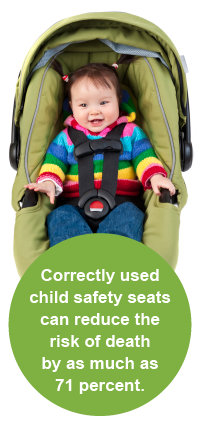 Driving needs to be safe for everyone traveling in a vehicle, but especially young children. They have no say, and are at the mercy of the driver. An extraordinary amount of young children are killed through no fault of their own, and purely because standard safety measures were not followed.
Driving needs to be safe for everyone traveling in a vehicle, but especially young children. They have no say, and are at the mercy of the driver. An extraordinary amount of young children are killed through no fault of their own, and purely because standard safety measures were not followed.
Troubling Statistics
According to the Association for Safe International Road Travel, each year 37,000 people die in car crashes in the United States. Though you’d think that a child’s life is the priority of any parent, there are a shocking number of children who are the victims of preventable deaths in car crashes due to negligence. According to the CDC, of children aged 12 and younger who die in car crashes, 34% of them were not buckled up. This is unacceptable, especially when it is so easy to make sure that a child is as safe as they can be within a vehicle. As well as this troubling statistic, it is made worse by the fact that the CDC also found that in one year more than 618,000 children rode in vehicles without a child safety seat, booster seat, or a seat belt.
Keeping a Child Safe Doesn’t Have to Be Hard
With 602 children aged 12 and younger dying in car crashes in 2014 alone, something needs to be done to educate parents on how to properly use and install an appropriate car seat for their children so they can be safer on the roads. This is because the use of a car seat reduces the risk of death for infants up to 1-year olds by 71%, and for those aged 1 to 4 the risk was reduced by 54%. These are not insignificant numbers, proving that the car seat can save the lives of children.
If a driver was distracted by something taking place within or outside their vehicle, and a crash happened, then children in car seats would come out better than those who weren’t. Learning to use a car seat isn’t hard.
Using a Car Seat for Your Child
The most common problem when using a child seat is selecting one which isn’t suitable for your child or for your car. If you can, try to test various car seats in your car before making a purchase so that you can make an informed decision on which seat best fits your car. A tight fit is good, as you don’t want the seat moving around in the event of a crash. The NHTSA also rates the safety of car seats, from 1 to 5 stars. If you can, try to purchase a 5-star seat for your child.
Once you’ve got a seat, you need to make sure that it is properly secured within your vehicle. If it is not, then the seat won’t be as effective and your child could still be susceptible to serious injury. Follow the manufacturer’s instructions on how to fit the car seat into your vehicle, and see if you can have an expert transportation safety professional help you out or double check that the fit of the seat is correct, so that you know the seat is as effective as it can be for your child.





